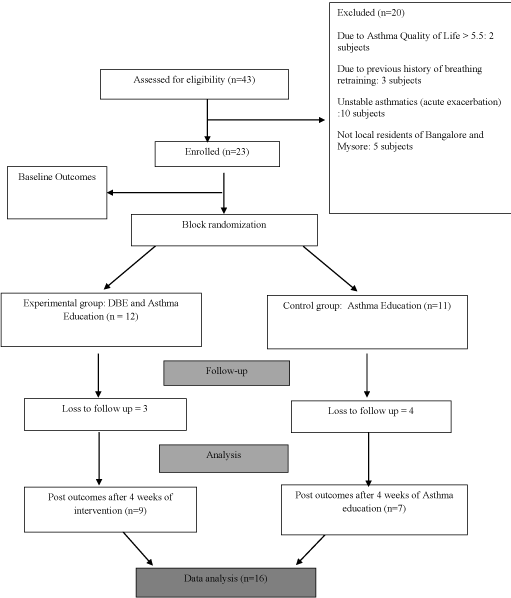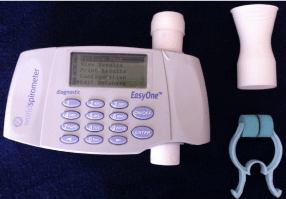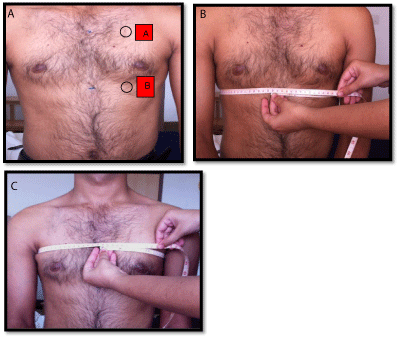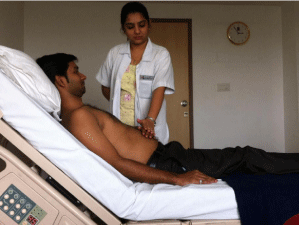
Research Article
Phys Med Rehabil Int. 2016; 3(6): 1100.
Effect of Diaphragmatic Breathing Exercise on the Quality of Life in Subjects with Asthma: A Randomized Pilot Trial
Syed N1,2*, Sukhvinder G² and Prem V²
¹Department of Physical Therapy, University of British Columbia, Vancouver, BC, Canada
²Department of Physical Therapy, School of Allied Health Sciences, Manipal University, Manipal, Karnataka, Indian
*Corresponding author: yed Nafeez, Department of Physical Therapy, University of British Columbia, 212 Friedman Building, 2177 Wesbrook Mall, Vancouver, Canada
Received: September 30, 2016; Accepted: October 19, 2016; Published: October 24, 2016
Abstract
Asthma is a chronic inflammatory disorder of the airways with an increasing prevalence globally by 50% every decade. Asthma not only affects the emotional and social dimensions, but also involves the physical aspects of health related quality of life. Despite breathing techniques occupy a major role in the nonpharmacological management of asthma; the effect of diaphragmatic breathing exercise alone in asthmatics with an impaired quality of life has not been studied. Results of this randomized pilot trail showed improvement in Asthma Quality of Life score in the intervention group with a mean difference of 1.0 at the end of 4 weeks, which is more than 0.5, the clinically important threshold for change in an individual patient. Significant improvement in respiratory rate and chest expansion were also noted. Despite the total AQLQ score did not change with 4 weeks of intervention, it demonstrated improvement in the activity levels compared to those in the control group. Thus, clinical practitioners may consider recommending diaphragmatic breathing exercise to asthmatics during the asymptomatic phase.
Keywords: Asthma; Diaphragmatic breathing; Quality of life; Chest expansion
Introduction
Asthma is a chronic inflammatory disorder of the airways. Chronically inflamed airways are hyper responsive, they become obstructed and airflow is limited (due to bronchoconstriction, mucous plugs and increased inflammation) when airways are exposed to various risk factors. It causes recurrent episodes of wheezing, breathlessness, chest tightness and coughing particularly at night or in early morning. It is reversible in nature [1]. Globally around 300 million people currently have asthma, with estimates suggesting that prevalence increases globally by 50% every decade [1]. The overall burden of asthma in India is estimated to be 2468 per 100,000 persons [2].
Asthma in adults is associated with a predisposition to anxiety and stress, sleep disturbances and they often feel tired and frustrated. Whereas, children and adolescents are found to have more behavioral problems, lower self-perceived health status and self-esteem, selfpity and sometimes embarrassment in taking medication. These not only highlight the impact of asthma on the emotional and social dimensions, but also on the physical aspects of health related quality of life [3]. Quality of life (QoL) is a subjective concept based on an individual’s perception of the impact that events and experiences have on his or her life. It measures five domains: physical, psychological, social, economic and spiritual. Measuring QoL has a role in describing health outcomes, guiding and assessing clinical management, predicting health outcomes, formulating clinical policy and allocating health resources [3].
Management of asthma includes both pharmacological and non- pharmacological approaches and the most commonly used forms of non-pharmacological approaches are acupuncture, aromatherapy, herbal products, homeopathy, yoga, prayer, diet therapy, vitamins and minerals, massage, positive therapy, physical therapy, breathing techniques [4-8] and breathing in conjunction with relaxation techniques [7]. Breathing techniques, such as Buteyko, diaphragmatic breathing and yoga are of considerable interest in asthma management [9]. Each of these teach breathing patterns with slow respiratory rate, acting as adjuncts to patient’s regular medical care and target decreased respiratory rate and increase in resting PCO2 to normal levels causing bronchodilation [7,8].
Diaphragmatic breathing exercise, a common breathing exercise studied in subjects with asthma has given positive findings in conjunction with other types of relaxation techniques [4-6]. A systematic review concluded that there is a moderate evidence of improvement in QoL following diaphragmatic breathing both in short and long-term basis and needs further research to confirm these results [10]. However, the effect of diaphragmatic breathing exercise alone in asthmatics with an impaired quality of life has not been studied. Hence the objective of the current trial was to examine the effect of diaphragmatic breathing exercise alone on the QoL, pulmonary function, respiratory rate and chest expansion in subjects with asthma. Authors hypothesized that Diaphragmatic breathing exercise will improve the QoL in subjects with asthma.
Methodology
This randomized pilot trial was approved by the institutional review boards of Manipal College of Allied Health Sciences (now known as School of Allied Health Sciences), Manipal University and PKTB Hospital, Mysore. The trial was conducted at Manipal Hospital, Bangalore & PKTB Hospital, Mysore. Diagnosedcases for asthma referred by departments of Pulmonology and Respiratory Medicine for physical therapy were considered in the study. A convenience sampling method was adapted and the subjects were randomized using block randomization. Subjects were randomized to groups using six blocks of four in each block. The flow of the pilot trial is shown in Figure 1.

Figure 1: Flow chart for the study.
Following a written informed consent participants were screened for inclusion and exclusion criteria. Subjects with controlled asthma, aged between 18-60 years of either sex, having a post bronchodilator increase of 200ml or 12% increase over baseline in FEV1, and having an Asthma Quality of life score (AQLQ) < 5.5 were included in the trial. Those who have a history of smoking, lesions in the lungs or pulmonary tuberculosis or other respiratory disorders, exposed to previous training on any of the breathing interventions, or any medical intervention which hampers the patient to perform diaphragmatic breathing exercise were excluded. Those meeting the eligibility criteria were enrolled into the study and baseline AQLQ, PFT, respiratory rate and chest expansion were collected before randomizing them into experimental and control groups.
Outcome measures
English version of the self-administered Asthma quality of life questionnaire (AQLQ) was used along with pulmonary function test (EasyoneTM diagnostic Spirometry System; Figure 2) in upright position (Figure 3), respiratory rate and chest expansion. The sites for measuring chest expansion used in this study are similar to those used in a previous study [11] and are shown in Figures4a, 4b and 4c.

Figure 2: Pulmonary Function Test Apparatus.

Figure 3: Subject performing a pulmonary function test in upright sitting.

Figure 4: Sites of chest expansion measurement; A – Axillary site; B –
Xiphoid process. B: Chest expansion measurement at xiphoid process. C:
Chest expansion measurement at axillary line.
Intervention group: Subjects in these groups were positioned in a semi-fowler’s position (Figure 5) where gravity assists the diaphragmatic excursion. Shoulder rolls or shoulder shrugs were performed to relax the muscles before performing the actual diaphragmatic breathing technique. Subject’s hand(s) are then placed over the rectus abdominis just below the anterior costal margin. Subject is instructed to breathe in slowly and deeply through the nose. By keeping the shoulders relaxed and upper chest quiet, allow the abdomen to rise slightly. Relax and exhale slowly through the mouth [12]. Subject was asked to practice this, three or four times and then rest and was advised to avoid hyperventilation. If the patient is having difficulty using the diaphragm during inspiration, then the subject would inhale several times in succession through the nose by using a sniffing action. This action was found to usually facilitate the diaphragm. Subject was taught to self-monitor this sequence, by placing his or her own hand below the anterior costal margin and feel the movement. It was ensured that the subject’s hand rises slightly during inspiration and lowers during expiration [13].

Figure 5: Positioning for diaphragmatic breathing exercise.
Subjects were asked to perform this diaphragmatic breathing for 15 minutes with appropriate breaks after every 6-8 breaths, twice daily for 4 weeks. During the third week, a telephonic contact was made with the subject to check the compliance to diaphragmatic breathing exercise, and address any queries if the subject had and provide clarifications if needed.Subjects were also provided with a daily log to record the frequency at which diaphragmatic breathing exercise was performed in a given day and the final outcomes were assessed at the end of 4 weeks.
Control group: Subjects in this group were educated on asthma management and identifying risk factors and prevention of exposure which could cause any discomfort or exacerbation. Routine pharmacological management was continued.
Statistical analysis
Data was analyzed using Statistical Package for Social Sciences (SPSS) version 16.0. Normal distribution was evaluated using histograms plotted for each variable. Wilcoxon Signed Rank Test was used for within group analysis and between groups was analyzed using Mann Whitney U test. Level of significance was considered p< 0.05 for this study. Also, “Number Needed to Treat” (NNT = 1 / absolute risk reduction) calculation was performed as recommended by Juniper and Guyatt to estimate the proportion of patients who had a clinically relevant change in their asthma related quality of life [14].
Results
Out of the 16 asthma subjects included, 9 subjects were randomized to intervention group and 7 to the control group. Baseline characteristics show no significant difference between the groups for all the outcomes, suggesting homogeneity of groups. The results are projected as median and inter quartile ranges as shown in Table 1.
Intervention group
Median (IQR)
(n = 9)
Control group
Median (IQR)
(n = 7)
Age (yrs)
24.00 (19.50 – 46.00)
47.00 (27.00 – 56.00)
Male /Female
N (%)
5 (56%) / 4 (44%)
2 (29%) / 5 (71%)
AQLQ
3.65 (3.01 – 4.31)
3.91 (3.02 – 4.15)
Symptoms
4.00 (2.66 – 4.58)
4.00 (2.60 – 4.50)
Activities
3.72 (3.17 – 4.63)
3.63 (2.45 – 3.90)
Emotion
3.60 (3.40 – 4.40)
3.80 (3.00 – 5.20)
Environment
3.75 (2.00 – 4.25)
4.25 (2.00 – 4.75)
RR (breaths / min)
22.00 (19.00 – 22.00)
23.00 (18.00 – 24.00)
Axillary site expansion (cm)
1.50 (1.50 – 2.00)
1.50 (1.50 – 1.75)
Xiphoid site expansion (cm)
2.00 (1.87 – 2.25)
1.50 (1.50 – 2.00)
FEV1 %
96.00 (72.00 – 98.00)
87.00 (78.00 – 98.00)
Chronicity of disease (yrs)
2.00(1.50 – 3.00)
4.00 (1.00 – 7.00)
AQLQ: Asthma Quality of life; FEV1 %: Forced Expiratory Volume in First Second; IQR: Inter Quartile Range; RR: Respiratory Rate.
Table 1: Demographics and baseline characteristics.
Statistically significant improvement in the total AQLQ score of the intervention group was noted (p = 0.01). Total AQLQ score in this group improved from 3.65 (3.01-4.31) to 4.86 (3.91-5.15). Similarly, the 3 sub-domains of symptoms, activity limitation and environmental stimuli improved from 4.0 to 5.1 (p=0.01), 3.7 to 4.81 (p=0.01) and 3.75 to 4.25 (p=0.02) respectively. Whereas, the control group showed no significant improvement in the total score as well as in the sub-domains of AQLQ (Table 2).
Intervention group (n=9)
Control group (n = 7)
Pre
Median (IQR)
Post
Median (IQR)
p value
Pre
Median (IQR)
Post
Median (IQR)
p value
AQLQ
3.65 (3.01 – 4.31)
4.86 (3.91 – 5.15)
0.01*
3.91 (3.02 – 4.15)
4.07 (2.55 – 4.52)
0.73
Symptoms
4.00 (2.66 – 4.58)
5.16 (3.75 – 5.37)
0.01*
4.00 (2.60 – 4.50)
2.83 (2.33 – 4.33)
0.73
Activities
3.72 (3.17 – 4.63)
4.81 (4.31 – 5.09)
0.01*
3.63 (2.45 – 3.90)
3.45 (2.81 – 4.90)
0.11
Emotion
3.60 (3.40 – 4.40)
4.80 (3.70 – 5.10)
0.09
3.80 (3.00 – 5.20)
3.60 (3.00 – 4.60)
0.50
Environment
3.75 (2.00 – 4.25)
4.25 (3.50 – 5.75)
0.02*
4.25 (2.00 – 4.75)
4.25 (2.5 – 6.00)
0.25
RR(breaths / min)
22.00 (19.00 –22.00)
18.00 (17.00–20.00)
0.01*
23.00 (18.00–24.00)
20.00 (17.00–20.00)
0.01*
Axillary site expansion(cm)
1.50 (1.50 – 2.00)
1.50 (1.50 – 2.00)
0.31
1.50 (1.50 – 1.75)
1.50 (1.50 – 2.00)
0.10
Xiphoid site expansion(cm)
2.00 (1.87 – 2.25)
2.50 (2.00 – 2.65)
0.01*
1.50 (1.50 – 2.00)
2.00 (2.00 – 2.00)
0.06
FEV1 %
96.00(72.00–98.00)
95.00 (72.50–98.00)
0.83
87.00 (78.00–98.00)
85.00 (79.00–97.00)
0.91
AQLQ: Asthma Quality of life; FEV1 %: Forced Expiratory Volume in First Second; IQR: Inter Quartile Range; RR: Respiratory Rate; *p < 0.05.
Table 2: Within group analysis for all the outcome measures.
Changes in respiratory rate showed significant improvement in both intervention and control groups with the respiratory rate changing from 22 to 18 breaths/min (p=0.01) and 23 to 20 breaths/ min (p= 0.01) respectively (Table 2). Changes in chest expansion showed significant difference only at xiphoid site (p= 0.014) with improvement from 2.00cm to 2.50cm in the intervention group. No significant difference was observed at the axillary site in both the groups and xiphoid site in the control group (Table 2). FEV1% demonstrated no significant difference in both intervention (96.0 – 95.0) and control (87.0 – 85.0) groups (Table 2).
Between group analysis showed statistically significant difference (p=0.05) only in the activity domain of AQLQ with the medians of interventional and control groups being 4.81 (4.31 – 5.09) and 3.45 (2.81 – 4.90) respectively. No significant difference was observed in the remaining domains of AQLQ and also in other outcome measures (Table 3). Using a minimal clinical important difference of 0.5 in AQLQ score to signify a clinically relevant change in an individual’s health status, the “number needed to treat” (NNT) to produce a clinically relevant improvement in the asthma related quality of life was calculated to be 2.04 (Table 4).
Intervention group
Median (IQR)
(n = 9)
Control group
Median (IQR)
(n = 7)
95 % Confidence Interval
p value
AQLQ
4.86 (3.91 – 5.15)
4.07 (2.55 – 4.52)
0.00 – 0.18
0.08
Symptoms
5.16 (3.75 – 5.37)
2.83 (2.33 – 4.33)
0.00 – 0.18
0.06
Activities
4.81 (4.31 – 5.09)
3.45 (2.81 – 4.90)
0.00 – 0.17
0.05 *
Emotion
4.80 (3.70 – 5.10)
3.60 (3.00 – 4.60)
0.00 – 0.37
0.16
Environment
4.25 (3.50 – 5.75)
4.25 (2.50 – 6.00)
0.71 – 1.00
0.75
RR (breaths/min)
18.00 (17.00 – 20.00)
20.00 (17.00 - 20.00)
0.31 – 0.80
0.47
Axillary site expansion (cm)
1.50 (1.50 – 2.00)
1.50 (1.50 – 2.00)
0.71 – 1.00
0.81
Xiphoid site expansion (cm)
2.50 (2.00 – 2.65)
2.00 (2.00 – 2.00)
0.00 – 0.28
0.07
FEV1 %
95.00 (72.50 – 98.00)
85.00 (79.00 – 97.00)
0.25 – 0.74
0.52
AQLQ: Asthma Quality of life; FEV1 %: Forced Expiratory Volume in First Second; IQR: Inter Quartile Range; RR: Respiratory Rate; *p < 0.05.
Table 3: Between group analysis for all outcome measures.
Sample
Improved = 0.5
Unchanged <0.5
NNT
Intervention group
9
7
2
2.04
Control group
7
2
5
Table 4: Number Needed to Treat (NNT) analysis.
Discussion
This study aimed to assess the effect of diaphragmatic breathing on the quality of life in stable asthmatic subjects’ demonstrated significant improvement in the diaphragmatic breathing group compared to control group. Intervention group showed improvement in Asthma Quality of Life score with a mean difference of 1.0 at the end of one month, which is more than 0.5, the clinically important threshold for change in an individual patient. Similar trend of improvement with a mean difference of 0.92 was observed by M Thomas et al [15] who compared short physiotherapy breathing retraining versus an asthma nurse education.
In the current study, symptom domain of AQLQ improved with a mean difference of 1.16 in the intervention group and is similar (1.02) to that noted in the past [15]. This could be due to decreased hyperventilation (respiratory rate) thereby raising ETCO2 levels causing dilatation of smooth muscles in the walls of the bronchi, bronchioles and alveolar ducts and thereby optimizing ventilation perfusion mismatch [16]. Also nasal breathing occurring concomitantly with diaphragmatic breathing cause’s filtration of bronchoconstriction agents such as allergens and polluting dust, and leads to bronchodilation of airways by humidification and production of nitric oxide [17]. A mean difference of 1.0 in the activity limitation domain of AQLQ was observed in the intervention group compared to 0.82 in the previous study. This increase could be attributed to the positive association between the decrease in the respiratory rate and decrease in symptoms in turn improving the activity levels. No statistical significant improvement was observed in the emotional function domain of AQLQ in the intervention group which could be due to duration of the intervention being shorter than needed to develop behavioral adaptations which surpass the emotional component associated with asthma [18]. In the environmental stimuli domain, significant improvement with a mean difference of 1.17 was observed which was higher than those reported in the past [15]. We hypothesize that the behavioral adaptations in their very primitive state and knowledge on the triggers due to recurrence of exacerbations could have led to the improvement in the intervention group. Also, breathing maneuvers like pranayama (yoga) have proved that slow, rhythmic pattern of breathing causes a reduction in psychological over-activity and emotional instability thereby decreasing vagal stimulation to the lung to cause bronchodilation and a small decrease in bronchial over activity [19]. Diaphragmatic breathing being similar to pranayama, could have possibly increased the threshold for airway reactivity in turn creating immunity to the environmental triggers.
Significant decrease was seen in respiratory rate of the intervention group, with a mean difference of 2.33 breaths per min which is in accordance with reports published by Benson and Klipper’s [20] reported a minimal important decrease of two breaths per minute. Diaphragmatic breathing requires slow, rhythmic inhalations and exhalations with emphasis on the diaphragm muscle moving downward on inhalation and upward on exhalation. The exhalation phase is longer than the inhalation phase leading to a decrease in respiratory rate [21]. FEV1%, though a sensitive indicator of airway obstruction did not show any significant difference in the intervention group which may be due to mild to moderate severity of the disease and subjects being stable asthmatics having an optimal level of baseline FEV1%. Chest expansion at xiphoid site was significant in the intervention group with a mean difference of 0.34cm whereas axillary site had no change in the same. Diaphragmatic breathing helps in increasing the lateral transmission of pressure, upward and outward motion of the lower ribs, which could have increased the chest expansion at xiphoid site [22]. The control group in the present study showed a significant change only in the respiratory rate with a mean difference of 3.28 breaths per min which could have been a spontaneous improvement. The other domains of AQLQ, chest expansion and FEV1% showed no significant improvement in the control group.
Between groups analysis showed no improvement in the total score of AQLQ and in the sub-domains (symptom, emotional function and environmental stimuli domain); however, the activity limitation domain of AQLQ showed improvement with a mean difference of 0.64. The physiological effects of diaphragmatic breathing exercise are varied, and it is claimed that this mode of exercise causes a decrease in the respiratory rate and reduces the work of breathing and dyspnea [21]. This could have acted as a positive feedback for the subject and helped in increasing the activity level. The other domains of AQLQ, respiratory rate, chest expansion and FEV1% showed no significant improvement in the control group.
In this study, the “number needed to treat” (NNT) to produce a clinically relevant improvement in the asthma related quality of life was found to be 2.04 which suggests that out of three subjects being treated, at least two subjects should show minimal clinical difference. Seven out of nine subjects showed improvement in our study which is in accordance with that as given by Thomas et al [23] where the NNT was found to be 1.96 after the intervention of 1 month.
Limitation
The smaller sample size of this study could be considered a limitation of this study.
Future Recommendations
Long duration and larger sample studies incorporating outcome measures such as airway inflammatory markers, end tidal carbondioxide, bronchial hyper-responsiveness is recommended.
Conclusion
Despite diaphragmatic breathing exercise was found not to be superior to usual care in changing the total AQLQ score with 4 weeks of intervention, it demonstrated improvement in the activity levels compared to those in the control group. Thus clinical practitioners may consider recommending diaphragmatic breathing exercise to asthmatics during the asymptomatic phase.
References
- Global Initiative for Asthma (GINA). Global strategy for asthma management and prevention. 2010.
- Gupta BM, Bala A. Mapping of asthma research in India: A scientometric analysis of publications output during 1999-2008. Lung India. 2011; 28: 239-246.
- Australian Centre for Asthma Monitoring. Measuring the impact of asthma on quality of life in the Australian population. AIHW Cat No. ACM 3. Canberra: AIHW. 2004.
- Ernst E. Complementary therapies for asthma: what patients use. J. Asthma. 1998; 35: 667–671.
- Cassandra AS, Helen KR, Christine RJ, Carol L A, Sinthia ZB. Complementary and alternative medicine use in asthma: Who is using what? Respirology. 2006; 11: 373–387.
- Partridge MR, Dockrell M, Smith NM. The use of complementary medicines by those with asthma. Respir Med. 2003; 97: 436–438.
- Chiang L, Ma WF, Huang JL, Tseng LF, Hsueh KC. Effect of relaxation-breathing training on anxiety and asthma signs/symptoms of children with moderate-to-severe asthma: A randomized controlled trial. Int J Nurs Stud. 2009; 46: 1061–1070.
- Holloway EA, West RJ. Integrated breathing and relaxation training (the Pap worth method) for adults with asthma in primary care: A Randomized Controlled Trial. Thorax. 2007; 62: 1039-1042.
- Holloway EA, Lasserson TJ. Breathing exercises for asthma. Cochrane Database Systemic Review. 2004; (1): No. CD001277.
- V Prem, RC Sahoo, P Adhikari. Effect of diaphragmatic breathing exercise on quality of life in subjects with asthma: A systematic review. Physiother Theory Pract. 2012; 1–7.
- Bocken HSE, Chen H. Julliard KN, Weedon J. Measuring Thoracic Excursion: Reliability of the Cloth Tape Measure Technique. J Am Osteopath Assoc. 2007; 107: 191-196.
- Kisner C, Colby LA. Therapeutic Exercise Foundations and Technique. 5th edn. Philadelphia: F. A. Davis Company; 2007. Chapter 25, Management of Pulmonary Conditions; p. 851-882.
- Masoli M, Fabian D, Holt S. Global Initiative for Asthma (GINA) program: the global burden of asthma: executive summary of the GINA Dissemination Committee report. Allergy. 2004; 59: 469-478.
- Guyatt GH, Juniper EF, Walter SD, Griffith LE, Goldstein RS. Interpreting treatment effects in randomized trials. BMJ. 1998; 316: 690–693.
- Thomas M, McKinley RK, Mellor S, Watkin G, Holloway E, Scullion J, et al. Breathing exercises for asthma: A Randomized Controlled Trial. Thorax. 2009; 64: 55–61.
- Cowie RL, Conley DP, Underwood MF, Reader PG. A randomized controlled trial of the Buteyko technique as an adjunct to conventional management of asthma. Respir Med. 2008; 102: 726–732.
- Bjermer L. The nose as an air conditioner for the lower airways. Allergy. 1999; 54: 26-30.
- Grammatopoulou EP, Skordilis EK, Stavrou N, Myrianthefs P, Karteroliotis K, Baltopoulos G, et al. The Effect of Physiotherapy-Based Breathing Retraining on Asthma Control. J Asthma. 2011; 48: 593-601.
- Singh V, Wisniewski A, Britton J, Tattersfield A. Effect of yoga breathing exercises (pranayama) on airway reactivity in subjects with asthma. Lancet. 1990; 335: 1381-1383.
- Benson H, Klipper MZ. The relaxation response. In: Benson H and Klipper MZ (eds) How to bring forth the relaxation response, p. 162–163. New York, Avon Books. 1975.
- Cahalin LP, Braga M, Matsuo Y, Hernandez ED. Efficacy of diaphragmatic breathing in persons with chronic obstructive pulmonary disease: a review of the literature. J Cardiopulm Rehabil. 2002; 22: 7–21.
- Vitacca M, Clini E, Bianchi L, Ambrosino N. Acute effects of deep diaphragmatic breathing in COPD patients with chronic respiratory insufficiency. Eur Respir J. 1998; 11: 408–415.
- Thomas M, McKinley RK, Freeman E, Foy C, Prodger P, Price D. Breathing retraining for functional breathing in asthma: A Randomized Controlled Trial. Thorax. 2003; 58: 110–115.